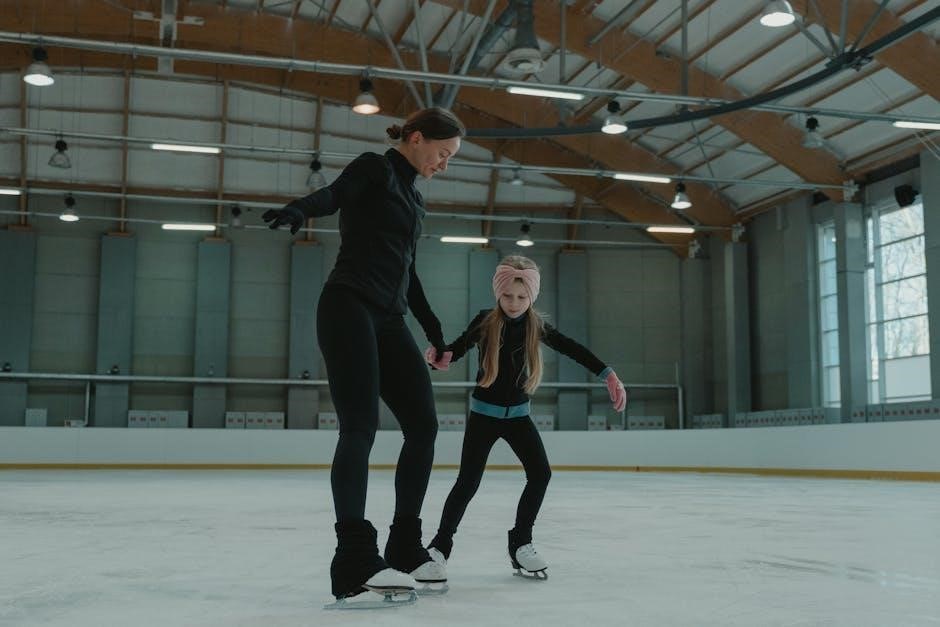Supraspinatus tendonitis affects the tendon connecting the supraspinatus muscle to the humerus, essential for shoulder stabilization and movement. Inflammation causes pain and mobility issues, often treated with targeted exercises.
1.1 Understanding the Condition
Supraspinatus tendonitis is an inflammatory condition affecting the tendon of the supraspinatus muscle, which stabilizes the shoulder joint and aids in abduction. It often results from repetitive overhead movements, poor posture, or acute injuries. Symptoms include localized pain, weakness, and restricted mobility. If untreated, it can progress to tendinopathy, characterized by degenerative changes. Early diagnosis and targeted exercises are crucial for managing symptoms and preventing further damage to the rotator cuff.
1.2 Importance of Exercise in Rehabilitation
Exercise is pivotal in rehabilitating supraspinatus tendonitis, enhancing tendon strength and joint stability. Targeted stretching and strengthening exercises, such as external rotations and scapular stabilization drills, improve mobility and reduce pain. Consistency in performing these exercises helps restore function and prevents recurrence. They also promote collagen remodeling, essential for tendon repair, making exercise a cornerstone in non-surgical management and long-term recovery.

Symptoms and Diagnosis of Supraspinatus Tendonitis
Symptoms include pain over the shoulder’s outer aspect, worsening with overhead activities. Diagnosis involves physical exams, imaging like MRI or ultrasound, and assessing range of motion.
2.1 Common Symptoms and Pain Patterns
Common symptoms of supraspinatus tendonitis include localized shoulder pain, especially during overhead activities, reaching, or lifting. Pain may radiate to the upper arm and worsen at night. Limited range of motion, tenderness, and weakness in shoulder muscles are also prevalent. Activities like throwing or repetitive arm movements often exacerbate symptoms, leading to reduced functional ability and discomfort during daily tasks.
2.2 Diagnostic Methods and Medical Evaluation
Diagnosis begins with a physical exam, assessing shoulder strength, range of motion, and tenderness. Imaging tests like ultrasound or MRI are used to confirm tendon inflammation or tears. Pain during specific movements, such as abduction or external rotation, may indicate supraspinatus involvement. A medical evaluation also considers the patient’s history and activity level to tailor a treatment plan, often including exercises to restore function and reduce pain.

Stretching Exercises for Supraspinatus Tendonitis
Gentle stretching exercises, such as cross-body and doorway stretches, target the supraspinatus tendon, improving flexibility and reducing stiffness to alleviate shoulder discomfort and enhance mobility.
3.1 Cross-Body Stretch
The cross-body stretch targets the supraspinatus tendon, improving flexibility and reducing stiffness. To perform, bring the affected arm across your body, placing your hand on the opposite shoulder. Use your unaffected arm to gently pull your hand toward your shoulder blade. Hold for 20-30 seconds and repeat 2-3 times. This stretch helps alleviate tension and enhances shoulder mobility, making it an essential part of rehabilitation routines for supraspinatus tendonitis.
3.2 Doorway Stretch
The doorway stretch effectively targets the supraspinatus tendon, promoting flexibility and relieving tension. Stand in a doorway with arms elevated at shoulder height, hands on the doorframe. Lean forward gently, stretching the front of your shoulders until a mild stretch is felt. Hold for 20-30 seconds, breathe deeply, and repeat 2-3 times. This exercise is ideal for improving range of motion and reducing stiffness in the shoulder region without causing discomfort.

Strengthening Exercises for the Supraspinatus
Strengthening exercises target the supraspinatus, enhancing shoulder stability and function. External and internal rotations, along with resistance band workouts, are key for restoring strength and preventing recurrence.
4.1 External Rotation Exercises
External rotation exercises are crucial for strengthening the supraspinatus muscle. Using resistance bands or light weights, these exercises involve rotating the arm outward while keeping the elbow close to the body. Proper form ensures the tendon is not strained, promoting healing and stability. Regular practice helps restore function and reduce pain, making these exercises a cornerstone of rehabilitation routines for supraspinatus tendonitis.
4.2 Internal Rotation Exercises
Internal rotation exercises target the supraspinatus muscle by moving the arm inward toward the body. Using resistance bands or light dumbbells, this motion strengthens the tendon and improves joint stability. These exercises are performed with controlled movements, avoiding pain, to enhance muscle endurance and flexibility. Consistency in practice helps prevent recurrence and supports long-term recovery from supraspinatus tendonitis, complementing external rotation exercises for a balanced rehabilitation approach.

Advanced Rehabilitation Techniques
Advanced techniques include resistance band exercises and dynamic stabilization drills to improve strength, flexibility, and joint stability, enhancing recovery from supraspinatus tendonitis and preventing future injuries effectively.
5.1 Resistance Band Exercises
Resistance band exercises are effective for strengthening the supraspinatus tendon and surrounding muscles. They involve using elastic bands to create tension, promoting controlled movements. Key exercises include external rotations and anchored pulls, which target the rotator cuff. These exercises improve muscle endurance and stability without overloading the tendon. Start with light resistance and progress gradually to avoid strain. Proper form is essential to maximize benefits and prevent further injury.
5.2 Dynamic Stabilization Drills
Dynamic stabilization drills focus on improving shoulder joint stability and proprioception. These exercises involve controlled movements that challenge the supraspinatus tendon and surrounding muscles. Examples include arm circles, shoulder blade squeezes, and dynamic rotational movements. Perform these drills with slow, deliberate motions to enhance neuromuscular control. Incorporate them into your routine to rebuild functional strength and prevent recurrence of tendonitis. Consistency is key for long-term shoulder health and stability.
Preventative Measures and Long-Term Management
Preventative measures include strengthening exercises, ergonomic adjustments, and proper warm-ups. Long-term management focuses on maintaining shoulder health through consistent exercise routines and avoiding repetitive strain injuries.
6.1 Warm-Up and Cool-Down Routines
A proper warm-up prepares the shoulder muscles for activity, reducing injury risk. Gentle exercises like arm circles and shoulder rolls are effective. After exercise, a cool-down with stretching helps improve flexibility and reduce muscle tension. Incorporating these routines into daily practice supports long-term shoulder health and prevents recurrence of supraspinatus tendonitis. Consistency is key to maintaining joint stability and overall muscle function.
6.2 Ergonomic Adjustments to Avoid Recurrence
Ergonomic adjustments are crucial to prevent supraspinatus tendonitis recurrence. Ensure proper workspace setup to avoid repetitive overhead movements or heavy lifting. Regular breaks and posture awareness can reduce strain. Modify activities to avoid repetitive stress on the shoulder. Strengthening exercises and proper equipment alignment further support tendon health. These adjustments promote long-term shoulder stability and reduce the risk of future injuries.

Creating a Personalized Exercise PDF Guide
A clear, comprehensive guide is essential for effective rehabilitation. Include detailed exercise routines, visual aids, and instructions to ensure proper form and progression.
7.1 Structuring the Guide for Clarity
Organize exercises logically, starting with stretches, then strengthening, and progressing to advanced techniques. Use headings, subheadings, and bullet points for easy navigation. Include sections for warm-up routines, daily schedules, and nutritional advice to support recovery. Clear instructions with visual cues ensure proper form and safety, making the guide user-friendly and accessible for individuals at all stages of rehabilitation.
7.2 Including Visual Aids and Instructions
Use high-quality images and diagrams to illustrate proper exercise form and muscle engagement. Step-by-step instructions should accompany each exercise, detailing starting positions, movements, and breathing techniques. Incorporate arrows or labels on images to highlight key actions. Include tips for avoiding common mistakes and modifying exercises based on fitness levels. Visual aids enhance understanding and ensure safe, effective execution of the exercises.

Monitoring Progress and Avoiding Overload
Track exercise consistency and pain levels to ensure progress without overloading the tendon. Adjust routines based on improvement or discomfort to prevent setbacks and promote recovery.
8.1 Tracking Exercise Consistency and Pain Levels
Regularly monitoring exercise consistency and pain levels is crucial for effective rehabilitation. Use a log or journal to track daily progress, noting the duration and intensity of exercises. While mild discomfort may occur, sharp pain indicates overexertion. Adjust routines based on pain thresholds to avoid aggravating the tendon. Open communication with healthcare providers ensures personalized adjustments, promoting safe and sustainable recovery without setbacks.
8.2 Adjusting the Routine Based on Progress
As progress is made, exercises should be tailored to current ability and goals. Gradually increase resistance or duration if pain subsides and strength improves. If symptoms persist, reduce intensity or consult a healthcare provider. Dynamic stabilization drills can be introduced to enhance functional movement. Regular reassessment ensures the routine remains effective and safe, promoting continued recovery without overloading the tendon.
Consistent exercise and proper management are key to recovery. Gradual progression and professional guidance ensure long-term shoulder health and functionality. Consult a healthcare provider for personalized advice.
9.1 Summary of Key Exercises and Practices
Key exercises for supraspinatus tendonitis include cross-body stretches, doorway stretches, external and internal rotations, and resistance band drills. These exercises aim to improve flexibility, strength, and joint stability. Consistent practice, proper form, and gradual progression are essential for optimal recovery. Incorporating these routines into a daily regimen can enhance shoulder function and reduce pain. Always consult a healthcare provider to tailor exercises to individual needs and ensure safe progression.
9.2 Importance of Continuous Rehabilitation
Continuous rehabilitation is crucial for long-term recovery from supraspinatus tendonitis. Regular exercises prevent recurrence, strengthen muscles, and improve joint stability. Consistency helps maintain flexibility and functionality, reducing the risk of future injuries. A well-structured rehabilitation plan ensures sustained progress and enhances overall shoulder health. Without ongoing effort, symptoms may return, making persistent adherence to rehabilitation essential for lasting recovery and optimal shoulder function.